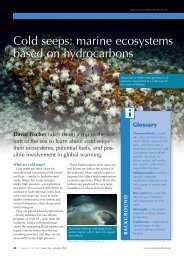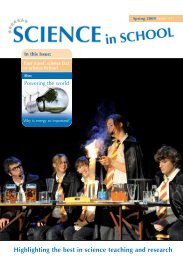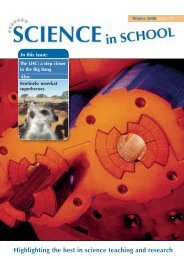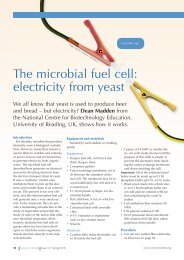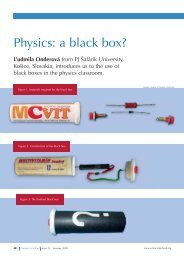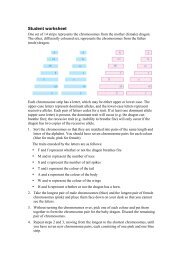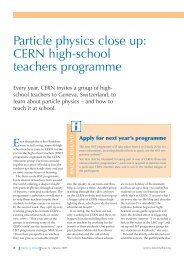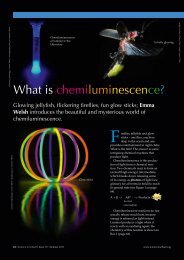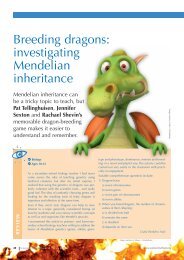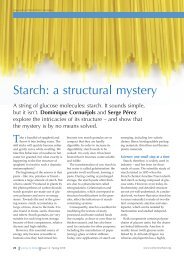Download Issue 14 as PDF [5.4 MB] - Science in School
Download Issue 14 as PDF [5.4 MB] - Science in School
Download Issue 14 as PDF [5.4 MB] - Science in School
Create successful ePaper yourself
Turn your PDF publications into a flip-book with our unique Google optimized e-Paper software.
Spectrometry at school:<br />
hands-on experiments<br />
nataša Gros, Tim Harrison, Irena Štrumbelj drusany and<br />
Alma kapun dol<strong>in</strong>ar <strong>in</strong>troduce a selection of experiments with<br />
a simple spectrometer designed especially for schools – and<br />
give details of how to perform one of the activities.<br />
To motivate school students<br />
through a hands-on approach to<br />
chemistry, we and our project partners<br />
developed a collection of experiments<br />
us<strong>in</strong>g small-scale, low-cost<br />
spectrometers. In the project, we used<br />
a simple school spectrometer developed<br />
by one of the partners (Nataša<br />
Gros). The spectrometer can be e<strong>as</strong>ily<br />
upgraded to form other analytical<br />
<strong>in</strong>struments, for example g<strong>as</strong> and liquid<br />
chromatographs, allow<strong>in</strong>g a further<br />
range of school experiments (see<br />
the project website w1 ). Limited numbers<br />
of the <strong>in</strong>struments are available<br />
for loan to schools.<br />
How spectrometers work<br />
In a spectrometer, the white light<br />
from a light source (a bulb) enters a<br />
monochromator, from which only<br />
light of the chosen wavelength<br />
(colour) emerges; this then p<strong>as</strong>ses<br />
through a solution <strong>in</strong> the optical cell,<br />
or cuvette (see Figure 1). The solution<br />
absorbs a fraction of the light and a<br />
detector me<strong>as</strong>ures the result<strong>in</strong>g reduction<br />
<strong>in</strong> the light <strong>in</strong>tensity (the<br />
absorbance). The deeper the colour of<br />
the solution, the higher the<br />
absorbance me<strong>as</strong>urement.<br />
The most widely used cuvettes<br />
have an optical path length of 1 cm<br />
and require at le<strong>as</strong>t 3 ml of solution<br />
for a successful me<strong>as</strong>urement. The<br />
ma<strong>in</strong> objective of a general-purpose<br />
spectrometer is accuracy and precision<br />
of absorbance me<strong>as</strong>urement: the<br />
wavelength selection should be <strong>as</strong><br />
accurate <strong>as</strong> possible and the light<br />
highly monochromatic (i.e., with a<br />
narrow range of wavelength). As a<br />
consequence, the construction of the<br />
<strong>in</strong>strument is complicated and not<br />
very obvious to a typical user – and<br />
the <strong>in</strong>strument itself is expensive.<br />
Instead, the ma<strong>in</strong> objective when<br />
develop<strong>in</strong>g the Spektra TM spectrometer<br />
w<strong>as</strong> to produce a low-cost,<br />
Image courtesy of Maren Beßler / Pixelio<br />
42 <strong>Science</strong> <strong>in</strong> <strong>School</strong> <strong>Issue</strong> <strong>14</strong> : Spr<strong>in</strong>g 2010<br />
www.science<strong>in</strong>school.org


![Download Issue 14 as PDF [5.4 MB] - Science in School](https://img.yumpu.com/26126440/44/500x640/download-issue-14-as-pdf-54-mb-science-in-school.jpg)


